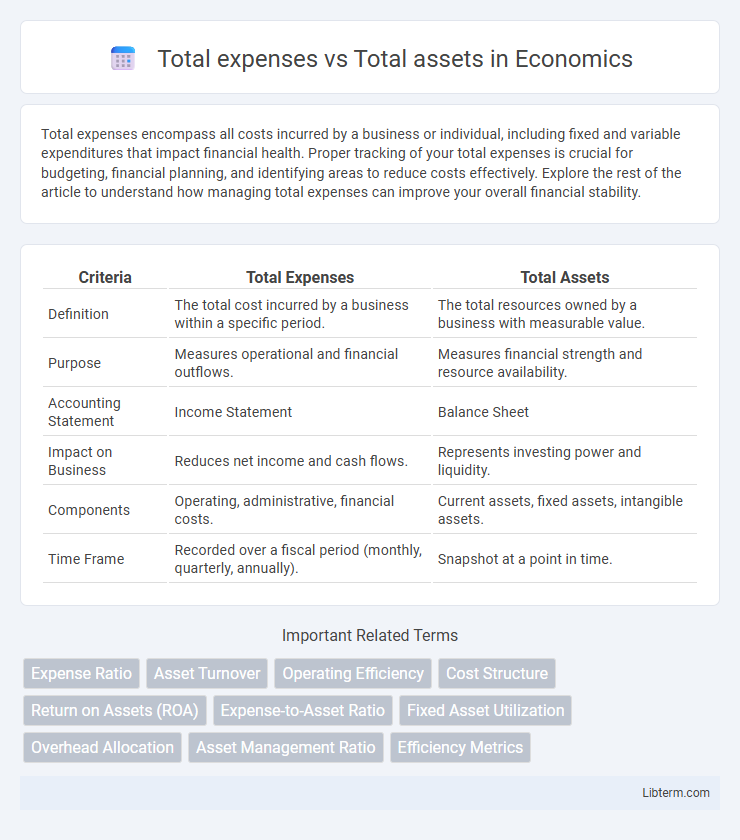Total expenses encompass all costs incurred by a business or individual, including fixed and variable expenditures that impact financial health. Proper tracking of your total expenses is crucial for budgeting, financial planning, and identifying areas to reduce costs effectively. Explore the rest of the article to understand how managing total expenses can improve your overall financial stability.
Table of Comparison
| Criteria | Total Expenses | Total Assets |
|---|---|---|
| Definition | The total cost incurred by a business within a specific period. | The total resources owned by a business with measurable value. |
| Purpose | Measures operational and financial outflows. | Measures financial strength and resource availability. |
| Accounting Statement | Income Statement | Balance Sheet |
| Impact on Business | Reduces net income and cash flows. | Represents investing power and liquidity. |
| Components | Operating, administrative, financial costs. | Current assets, fixed assets, intangible assets. |
| Time Frame | Recorded over a fiscal period (monthly, quarterly, annually). | Snapshot at a point in time. |
Understanding Total Expenses and Total Assets
Total expenses represent the complete costs incurred by a business during a specific period, including operating, administrative, and financial costs. Total assets encompass all resources owned by the company, such as cash, inventory, property, and equipment, reflecting the organization's financial strength and capacity for generating future revenue. Understanding the relationship between total expenses and total assets helps evaluate operational efficiency and asset utilization to maintain profitability and sustainable growth.
Key Differences Between Total Expenses and Total Assets
Total expenses represent the costs incurred by a company during a specific period, impacting net income and cash flow directly, whereas total assets reflect the overall resources owned by the company at a point in time, including cash, inventory, property, and equipment. Expenses are recorded on the income statement and decrease equity, while assets appear on the balance sheet and serve as economic resources to generate future revenue. Understanding the distinction between these financial metrics is crucial for assessing a company's operational efficiency versus its financial stability and investment capacity.
Why Tracking Total Expenses Matters
Tracking total expenses is crucial for maintaining financial health and ensuring effective budget management by revealing spending patterns relative to total assets. Monitoring total expenses helps identify inefficiencies and potential areas of cost reduction, preserving asset value and supporting long-term financial stability. Accurate expense tracking also enables better forecasting and strategic allocation of resources, maximizing asset utilization and profitability.
The Role of Total Assets in Financial Health
Total assets represent the comprehensive value of everything a company owns, serving as a key indicator of its financial stability and capacity for growth. Comparing total expenses to total assets helps assess operational efficiency, revealing whether a company is effectively leveraging its asset base to generate profits. A lower ratio of total expenses to total assets typically signifies stronger financial health and better asset management.
Calculating Total Expenses: Essential Components
Calculating total expenses involves aggregating all cost elements such as operating expenses, cost of goods sold, administrative costs, and depreciation. These components provide a clear picture of financial outflows necessary to sustain business operations. Comparing total expenses against total assets helps evaluate asset efficiency and overall financial health by indicating how well resources generate revenue.
Assessing Total Assets: What Should Be Included
Assessing total assets requires including current assets such as cash, accounts receivable, and inventory, as well as long-term assets like property, equipment, and intangible assets including patents and goodwill. Accurate valuation methods and regular asset revaluation ensure that total assets reflect true financial strength. Excluding liabilities and expenses from total assets provides a clear distinction, critical for precise financial analysis and decision-making.
Total Expenses vs Total Assets: Impact on Profitability
Total expenses as a percentage of total assets directly influence a company's return on assets (ROA), which measures profitability by indicating how efficiently assets generate earnings. High total expenses relative to total assets reduce net income, thereby decreasing ROA and signaling lower asset utilization efficiency. Optimizing the balance between total expenses and total assets is crucial for maximizing profitability and sustaining financial health.
Financial Ratios Involving Expenses and Assets
The ratio of total expenses to total assets measures a company's efficiency in managing its resources by comparing operational costs to the asset base, providing insight into asset utilization. A lower expense-to-asset ratio indicates better cost control and asset productivity, which is crucial for financial stability and profitability assessments. This financial metric is integral to evaluating operational performance alongside other ratios like return on assets (ROA) and asset turnover.
Strategies to Optimize Expenses and Grow Assets
Implementing comprehensive budgeting techniques and regularly analyzing financial statements can optimize expenses and enhance asset growth. Prioritizing high-impact investments and minimizing discretionary spending improves total asset accumulation while controlling total expenses. Leveraging technology for expense tracking and asset management facilitates informed decision-making and sustainable financial growth.
Common Mistakes When Analyzing Expenses and Assets
Misinterpreting total expenses as equivalent to total assets can lead to flawed financial analysis since expenses represent outflows affecting profitability, while assets signify resources owned by the company generating future economic benefits. Overlooking the timing difference between expenses incurred and asset acquisition causes inaccurate assessment of financial health. Confusing non-cash expenses like depreciation with asset liquidation further distorts the evaluation of a company's true asset base.
Total expenses Infographic

 libterm.com
libterm.com